 |
|
Here and There introduces art, artists, galleries and museums around Japan that non-Japanese readers and first-time visitors may find of particular interest. The writer claims no art expertise, just a subjective viewpoint acquired over many years' residence in Japan.
|
|
 |
|
|
 |
 |
The Roppongi Vortex: Contemporary Art Galleries Reunite in Complex665
Alan Gleason |
 |
|
The entrance to the Complex665 building in Roppongi. Photo by Alan Gleason |
For several years, a number of Tokyo's most intrepid and successful contemporary art galleries have led a nomadic existence, moving -- sometimes as lone wolves, sometimes in packs -- from one converted warehouse to another. Most of these no-frills spaces have been situated in the low-rent industrial zone along the Sumida River, east of Ginza. Within a few years of each relocation, however, developers have purchased the buildings, razed them to make room for highrise condos, and forced the galleries to move on.
Last fall a triad of galleries that had shared space in these previous incarnations reunited to occupy a spanking new building in Roppongi, where a rapidly burgeoning crop of art institutions large and small, boasting a glossy architectural sheen and cutting-edge vibe, threatens to render the stodgy Ginza gallery district obsolete. The wherewithal to occupy such high-rent premises speaks not only to the success of these particular establishments, but to the determination of Roppongi developers to transform the neighborhood into Tokyo's new art center. One builder in particular, Mori Building Co., Ltd., was instrumental in luring the Sumida galleries to Complex665, a sleek three-story structure built just for them in the shadow of the 54-story Mori Tower at Roppongi Hills. Mori has been a major mover and shaker in the transformation of Roppongi's image from seedy entertainment quarter to uberhip art and fashion mecca. (Relax, nightcrawlers, plenty of Roppongi remains as seedy as ever!)
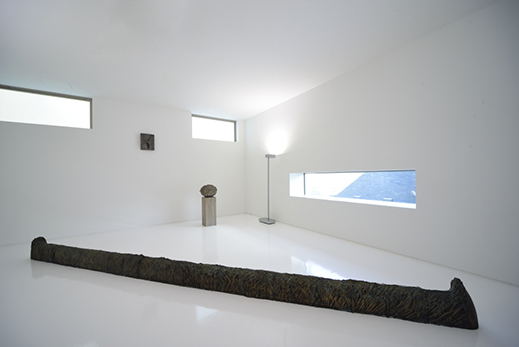 |
|
Animal Track II installation view, Shigeo Toya: Woods X exhibition, ShugoArts, 2017. © the artist / courtesy of ShugoArts; photo by Shigeo Muto |
Located on a quiet alley just a block behind the bustling Roppongi crossing, Complex665 opened last October. Its three tenant galleries, ShugoArts, Taka Ishii, and Tomio Koyama, were neighbors on the top floors of the Maruhachi Warehouse, an imposing edifice on the east bank of the Sumida that fell to the wrecking ball two years ago. (See Here and There's 2009 report on the Maruhachi scene.) In the interim Taka Ishii and Tomio Koyama shared a building in Kitasando while ShugoArts bided its time in Mishuku. Now they are together again in digs that, while less roomy than the old warehouse spaces, are indubitably spiffier.
In moving to Roppongi they are also reunited with another former Maruhachi gallery, hitomiyoshii, which has resurfaced just down the street. Across the alley, the Pyramide Building houses several more galleries, making this a go-to neighborhood for art mavens. Anchoring the new arts nexus are three larger institutions that constitute the self-styled "Art Triangle Roppongi": the Mori Art Museum atop the aforementioned skyscraper, the Suntory Museum of Art in the nearby Tokyo Midtown highrise, and the massive National Art Center, Tokyo.
 |
|
Shigeo Toya, Woods X (2016), wood, wood ash, acrylic, 220 x 31 x 31 cm each, 30 pcs. © the artist / courtesy of ShugoArts; photo by Shigeo Muto |
The exhibitions currently up at ShugoArts and Taka Ishii are two good reasons to visit Complex665 as soon as possible this month. Until 5 February ShugoArts features the powerful work of wood sculptor Shigeo Toya (b. 1947). The show's namesake centerpiece, Woods X, fills the entire front room. Visitors can walk through this forest-like grid of 30 two-meter-high columns of sugi cedar, all chainsaw-carved into gnarled phantasmic shapes that would look right at home in a Grimm fairy tale. This is the tenth iteration of a series that Toya has devoted himself to since 1987. In an interview (available in English translation), the artist explains how these convoluted surfaces represent not only woods but the mountains and valleys of Japan's rugged topography, and even the trails and tunnels that animals burrow through and under the trees. In the next room one encounters a six-meter-long bronze tube titled Animal Track II which, Toya explains, he envisions as a cast of just such a path. This is work that arouses a gamut of deep-seated emotions, tapping in to primordial and contemporary sensibilities all at once.
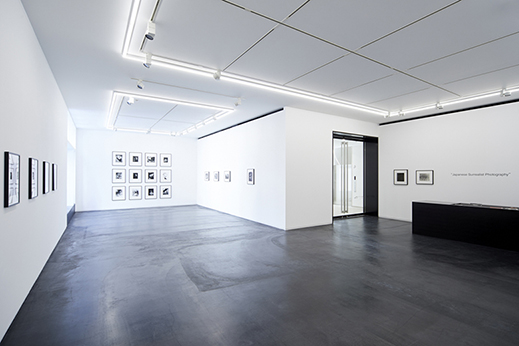 |
|
Japanese Surrealist Photography installation view at Taka Ishii Gallery, Tokyo. Photo by Kenji Takahashi / courtesy of Taka Ishii Gallery |
Taka Ishii specializes in photography. Until 4 February it is displaying Japanese Surrealist Photography, a small but enlightening (and highly entertaining) selection of works by six Japanese surrealists: Kansuke Yamamoto, Toshiko Okanoue, Iwata Nakayama, Osamu Shiihara, and Nakaji Yasui. Nearly all were born around the turn of the previous century and were active by the 1930s. An exception is Okanoue (b. 1928), who produced her work for only a short period in the early 1950s. Her photo-collages are particularly eye-catching for their hilarious deconstructions of the human body -- horseheads on human torsos, a nun's head parachuting down to a perch on her neck, a woman with a folding fan for a head.
Yamamoto (1914-87), a pioneer in avant-garde photography who was also a poet, painter, and sculptor, meanwhile rates a concurrent exhibition all to himself at another Taka Ishii venue in Roppongi. This is the somewhat confusingly named Taka Ishii Gallery Photography / Film, which is found on the second floor of the Axis Building, a multipurpose shop-and-showroom center a few minutes' walk from Complex665. Yamamoto and other Japanese avant-gardists were harshly suppressed by the police during the war, but quickly made up for lost time in the fifties. Though the surrealists fell out of favor with the advent of the realist photographers of the sixties, Yamamoto has enjoyed a critical reappraisal in recent years, and this show is a good opportunity to see why.
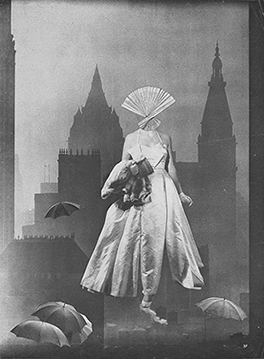 |
|
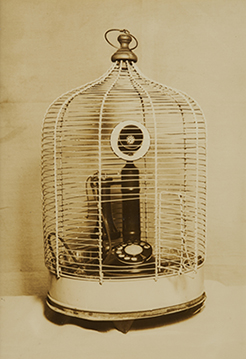 |
|
Toshiko Okanoue, Visit in Night (1951), platinum print. © the artist / courtesy of amanasalto, The Third Gallery Aya and Taka Ishii Gallery |
|
Kansuke Yamamoto, Buddhist Temple's Bird Cage (1940), gelatin silver print. © Toshio Yamamoto, the Estate of Kansuke Yamamoto / courtesy of Taka Ishii Gallery |
The Complex665 experience would not be complete without a visit to the flagship gallery of Tomio Koyama, a major player on the global contemporary art market. Despite its peripatetic venue-hopping in recent years, the gallery (which has also opened a separate space in Shibuya's Hikarie building) has not lost a step in its rise to prominence on the Tokyo scene. Currently showing until 4 February are the paintings of Buenos Aires-born, London-based Varda Caivano. The arched ceiling of one of the Koyama rooms nicely complements the quiet blues and grays of Caivano's recent work; it's also a refreshing departure from the straight lines and sharp angles that predominate throughout Complex665. One starts wishing that the architect had thrown in a few more curves.
In some ways I miss the funky industrial ambience of the old Maruhachi galleries, with their rickety freight elevators and exposed rafters. Yet it is also impressive to see what a difference active support of the arts by a city's private sector can make, as demonstrated in Tokyo by the shiny new galleries and museums that seem to keep popping up like mushrooms in Roppongi and other posh or poshifying neighborhoods.
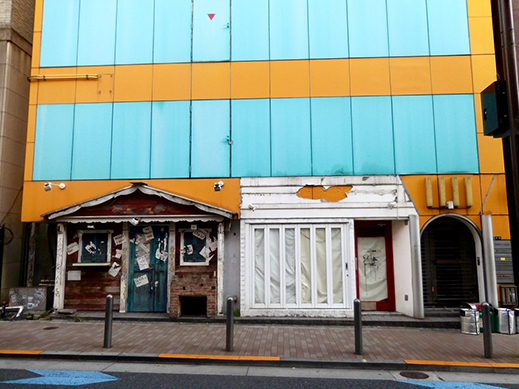 |
|
Vestiges of the old Roppongi. Photo by Alan Gleason |
|
|
| |
 |
Alan Gleason
Alan Gleason is a translator, editor and writer based in Tokyo, where he has lived for 30 years. In addition to writing about the Japanese art scene he has edited and translated works on Japanese theater (from kabuki to the avant-garde) and music (both traditional and contemporary). |
|
|
|
|
|
|
|
|
|
 |
|